| North of the tourist
village of Elounda is the small island of Spinalonga with the Venetian
fortification from 1579.
|
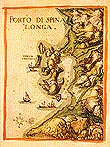
|
| There are various
explanations for the name of the island:
|
| 1. Some people think that is
composed of the Italian words: spina (thorn) and longa (long).
|
| 2. In older Venetian
manuscripts the island is mentioned as Stinelonda, which simply means
"at Elounda". This also indicates the importance of the island
as fortification for the ancient town of Oloús, which was situated at the
present Elounda.
|
| 3. The island was called
Spirlonga in Turkish, and a myth says that the Turks used this name,
because a very beautiful princess by the name of Longa lived on the island
in old times. She had many suitors but none of them lived up to her
expectations. When she was pressured to make her choice, she promised to
marry the man who was able to bring water to the island from the rich
springs near the village of
Kritsa, as the island did not have a spring of its own. A young man by the
name of Spiro managed the task, and preparations for the wedding were
started. But immediately before the wedding ceremony Longa threw herself
into the sea from a rock and drowned. After this the island was named
after the two young people: Spiro-Longa.
|
| Even though the myth is
picturesque, the most plausible explanation for the name of the island is
no. 2.
|
| As a part of the their
extensive web of fortifications against the Turkish danger, the Venetians
constructed the fortress on Spinalonga in 1579 and provided it with no
less than 35 canons. The fortress was built on the foundation of an
earlier castle, in which the Christians had taken refuge, when the
Saracens attacked the island in 828.
|
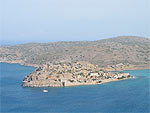
|
|
|
|
| After having besieged
Megalo Kastro - the present Iraklion - for 20 years, the Venetians had to
hand over the town to the Turks who by this got the power of the whole of
Crete, except for some small island for example Spinalonga, which did not
become Turkish until 1715.
|
| At the beginning of the 19th
century the tensions between the Christians and the Muslims increased, and quite a few Turks fled to Spinalonga. 81
Turkish families lived on the island in 1834, and the number of
inhabitants had reached more than 1.000 in 1881. |
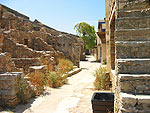
|
|
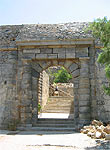
|
The last chapter in the history
of the island started in 1903, when the first government in Crete's period
of independence (Kritiki Politia) opened a "hospital" for lepers
on the island. At that time there was no therapy for leprosy, so the
government wanted to intern the lepers from the rest of the population of
Crete, and on October 13th 1904 the first lepers arrived at the island. |
|
|
|
|
|
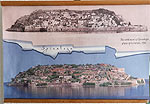 |
Till then, the lepers
had been living outside the towns in miserable conditions. The Austrian
doctor F. W. Sieber
portrays their circumstances in his travel
description from Crete in 1817:
|
|
|
| ...
After visiting a good part of vegetable gardens, all looking identically,
with Dominico, we made a trip outside the town
[Iraklion], where
we found many rare plants and insects. There I saw, for the first time,
some lepers who lived at an isolated area outside the walls of
Iraklion, for they were forbidden to enter the town. I shuddered at the
sight of their great misery. Many of them had lost hands and feet, and
they showed their mutilated arms and legs, asking for mercy and handouts
with strident voices and inarticulate and nasal sounds. ...
|
| ...
Outside the town walls
[of
Melidoni] were some miserable hovels,
where the lepers lived. They asked for handouts but not for relief, as
they had long ago lost any hope. Their misery was indescribable. ...
|
| On Spinalonga the lepers lived
in isolation and their only contact with the outside world was a little
boat, bringing food and mail to the island.
|
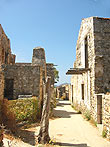
|
|
They therefore created their
own society on the island, building houses, cafés, taverns and shops.
They even built a school where a leper teacher taught the children. Life
took its course with marriages and childbirths, and during the period of
1904-1926, 39 children were born, of which 16 died.
|
| In 1873 the Norwegian doctor
and zoologist Armauer Hansen discovered the leper-bacillus, after which it was possible
to cure the illness. But the leper-hospital on Spinalonga was not closed
until 1957, where the patients were taken to a hospital in Athens.
|
| Boats for Spinalonga depart
from Agios Nikolaos, Elounda or from Plaka, situated only 200-300m from
the island and still tolerably unaffected by the mass tourism of the other
two towns. |
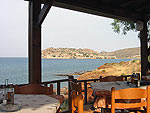
|
|
|
|
| I took the first boat
from Plaka (at 10 o'clock a.m.), so I had the opportunity of taking
photographs before too many visitors arrived at the island.
|
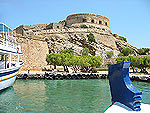
|
|
The boat berths below the large
Mocenica bastion.
|
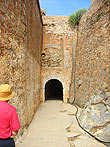 |
A tunnel leads from the harbour
through the walls of the fortress into the village. |
|
The tunnel opens into the
Turkish quarter where several of the old shops have been restored. |
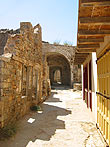
|
|
|
|
|
 |
The street continues to an open
square with a church. To the left is one of the Venetian cisterns and the
washing vessels where poor women from the nearby villages in Crete did the
washing for the sick. |
|
|
|
|
| Shortly after, a street leads
down to the left towards the main gate where the boat with the lepers
berthed. Just inside the gate is the large room where the priest, the
doctors, the nurses and the washerwomen must be disinfected, before they
were allowed to leave the island. |
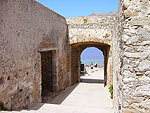
|
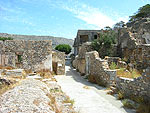 |
A little further along the
street are the big hospital buildings. |
| On the north side of the island
is the Michiel bastion. |
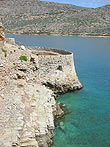
|
|
|
|
|
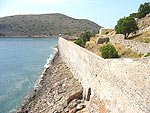 |
Continuing further on, you see
the big fortification walls, some water reservoirs and the St George
church. |
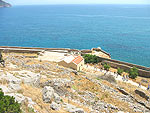
|
|
|
|
|
|
|
The lepers' graveyard is to the
left at the end of the stroll. |
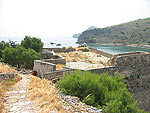
|
















